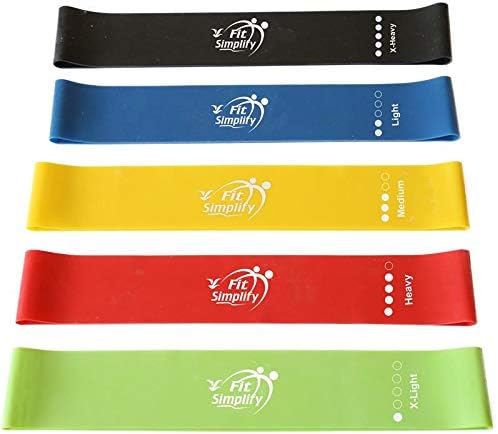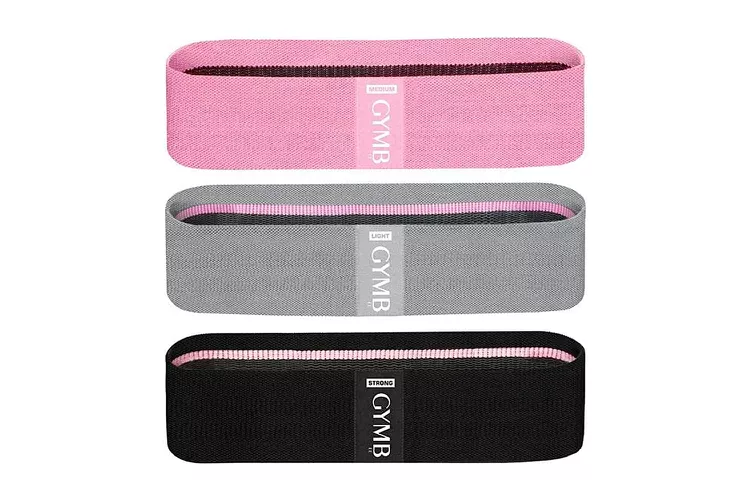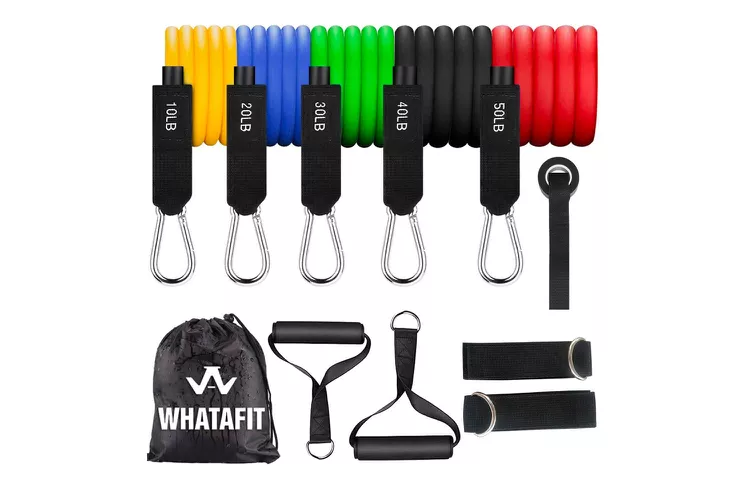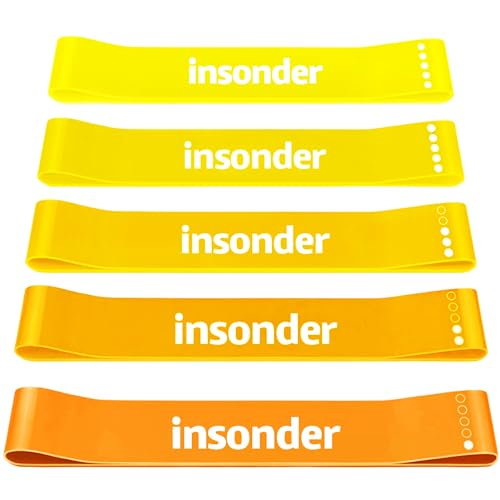Resistance bands come in various packs with different levels of thickness and attachments, helping you diversify your workouts. Unlike traditional weights, you can’t endlessly load with them, but they are highly effective for strength and muscle building. The Journal of Sports Science & Medicine supports their use, noting significant improvements in flexibility.
Additionally, research indicates that resistance bands can enhance explosive power for strength training athletes. As long as your muscles are challenged, resistance bands can help you develop strength.
We tested and reviewed the best resistance bands at home and in the gym, selecting nine top options based on their strength, usability, budget, and features like grip and value.
Our Top Picks
| Image | Product | Feature | Price |
|---|---|---|---|
|
Best Overall

|
Fit Simplify Resistance Loop Exercise Bands
|
|
Check Price |
|
Best runner up Loop

|
GYMB Non-Slip Resistance Bands
|
|
Check Price |
|
Best Budget

|
Insonder Resistance Bands Set
|
|
Check Price |
|
Best Budget Tube

|
Whatafit Resistance Bands Set
|
|
Check Price |
1. Fit Simplify Resistance Loop Exercise Bands
If you are looking for a simple and convenient way to improve your fitness, tone your muscles, and enhance your flexibility, then you will love the Fit Simplify Resistance Loop Exercise Bands. These bands are made of 100% natural latex, which is durable, elastic, and skin-friendly.
They come in five different resistance levels, from extra light to extra heavy, so you can choose the one that suits your needs and goals. Whether you are a beginner or an advanced exerciser, you can use these bands for a variety of workouts, such as yoga, pilates, strength training, power weight programs, and more.
You can also use them for physical therapy, rehabilitation, and injury prevention. The bands are easy to carry and store, as they come with a handy travel bag and an instruction guide. You will also get access to an online video workout guide and a 41-page e-book with dozens of illustrated exercises that show you how to use the bands for different body parts.
With the Fit Simplify Resistance Loop Exercise Bands, you can get a full-body workout anytime, anywhere, and achieve your fitness goals faster and easier.
2. GYMB Non-Slip Resistance Bands
These loop bands are ideal for those who want to challenge their lower-body workouts with affordable and reliable resistance. These bands are made of cotton cloth, which makes them comfortable and durable. They come with a handy carrying bag and an instruction booklet that shows you how to use them effectively.
These bands have a thick fabric that can withstand repeated use without losing their elasticity or resistance. They offer three levels of resistance—“light,” “medium,” and “strong”—that are suitable for intermediate to advanced exercisers.
Each band has a clear label that indicates the resistance level, as well as a rubber grip on the inside that prevents them from sliding or rolling up. Their thick and wide design also ensures that they don’t cut into your skin.
However, these bands may have some drawbacks. The lightest resistance level may still be too hard for beginners, and the color coding system for the resistance levels may not be very intuitive.
3. Insonder Resistance Bands Set
If you are looking for a versatile and affordable set of loop bands, you might want to check out Insonder’s Mini Bands. They come in five different resistance levels, from 10 to 40 pounds, so you can easily adjust the intensity of your lower-body workouts as you progress.
The bands are made of high-quality latex with a chalk-like coating that keeps them clean and comfortable on your skin. They are also very light and come with a handy mesh bag, so you can take them anywhere you go.
The bands are clearly marked with dots that indicate their resistance level, so you won’t have any trouble finding the right one for your exercise. The bands are also very sturdy and resilient, so you don’t have to worry about them breaking or snapping during your workouts. Whether you are a beginner or an advanced exerciser, you will find these bands useful and effective for toning and strengthening your legs, glutes, hips, and core.
One thing to keep in mind is that these bands may slide a bit when you sweat, so you may need to reposition them occasionally. Also, unlike some other band sets, this one does not include an exercise guide, so you may have to look for some online resources or videos to get some ideas on how to use them.
4. Whatafit Resistance Bands Set
If you are looking for an affordable and versatile training system that can give you a full-body workout at home, you might want to check out Whatafit’s Resistance Bands Set. This set comes with five latex tube bands that have different levels of resistance, from 10 to 50 pounds.
You can easily attach them to the two foam handles, two ankle straps, or the door anchor that are also included in the set. The tube bands are comfortable and secure to use, thanks to the foam handles and the carabiner clips.
You can also follow the instruction booklet that comes with the set, which shows you how to do various exercises with the tube bands and accessories. The booklet is very helpful for beginners who are not familiar with tube band workouts.
What to Know Before You Buy
Resistance bands come in various strengths and styles. Some packs even offer different attachments like ankle cuffs, door jambs, or handles. Here are the main types of resistance bands:
Mini Bands/Loop Bands
- Perfect for glute exercises like crab walks, glute kickbacks, and fire hydrants.
- Help with muscular activation and can sit above the ankles or knees during exercises.
Long Bands/Tube Bands
- Typically come with attachable handles for exercises like rows, squats, and deadlifts.
- Often include a door jamb and a manual for different moves, versatile for upper and lower-body workouts.
Power Bands
- Thick bands primarily used for assisting exercises like pull-ups or lat pull-downs.
- Less versatile but excellent for providing additional support.
Long Bands
- Available in various resistance levels, from super thin to very thick.
- Typically looped, larger than mini bands, and used for both upper and lower body exercises.
Physical Therapy Bands
- Offer minimal resistance, ideal for therapy exercises, stretches, and recovery.
- Super stretchy and sometimes chalky in texture.
Benefits of Resistance Bands
Incorporating resistance bands into your workout routine offers numerous advantages beyond traditional weightlifting methods.
Portability
- Lightweight and compact, making them easy to carry and perfect for travel.
- Allows for strength training without needing a gym, ideal for busy schedules.
Versatility
- Suitable for upper-body exercises like bicep curls and shoulder presses, lower-body exercises like squats and lunges, and core exercises like banded dead bugs.
- Can be used for a variety of exercises, enhancing your workout routine.
Joint-Friendly
- Provide constant tension throughout movements, reducing stress on joints.
- Excellent for individuals with joint issues, as they strengthen muscles without aggravating existing conditions.
Adjustable Resistance
- Intensity can be adjusted by using bands with different resistance levels.
- Acts like a whole set of weights in one compact package, ideal for progressive overload.
Functional Strength Building
- Allows for the mimicry of real-life movements more closely than traditional weightlifting.
- Improves functional strength for better performance in daily activities and sports.
Cost-Effective
- Affordable compared to gym memberships or bulky exercise equipment.
- High-quality bands are available at a fraction of the cost of other equipment.
Caters to All Fitness Levels
- Beginners can start with lighter resistance bands and progress to higher levels as they build strength.
- Advanced users can combine multiple bands or adjust their positioning to increase the challenge.
Enhances Flexibility and Range of Motion
- Facilitates dynamic stretching exercises that improve flexibility and range of motion.
- Strengthens muscles in their elongated positions, promoting better overall mobility.
Ideal for Rehabilitation
- Recommended by physical therapists for rehabilitation purposes due to their gentle yet effective resistance.
- Helps target specific muscles and gradually reintroduce movement after an injury.
Engages Stabilizing Muscles
- Requires the engagement of stabilizing muscles to control movements, unlike machines.
- Improves overall muscular balance and helps prevent injuries by strengthening often-neglected muscles.
Can Reduce Body Fat
- Research indicates that training with resistance bands can reduce body fat in individuals with overweight or obesity
How to Buy the Best Resistance Band for You
Choosing the right resistance bands involves considering several factors to ensure you get the most value and effectiveness for your fitness routine. Here’s a detailed guide to help you make an informed decision.
Consider Your Budget
Start by setting a budget. Some high-end resistance band kits can cost over $100, but you can find decent sets for under $30. While it’s essential to stick to your budget, remember that poor-quality bands can pose a safety risk, as they are prone to breaking and causing injury.
Types of Resistance Bands
Resistance bands come in various styles, each suited to different types of exercises:
Mini Bands/Loop Bands
- Ideal for lower-body exercises like squats, fire hydrants, and glute kickbacks.
- Can also be used around forearms for upper-body exercises like shoulder raises.
Superbands
- Large, durable bands perfect for adding significant resistance.
- Used for assisted pull-ups, chin-ups, squats, and overhead presses.
Tube Bands
- Feature handles on each end, making them great for upper-body exercises like bicep curls, shoulder presses, and rows.
- Often come with door anchors for added stability and a wider range of exercises.
Physical Therapy Bands
- Offer light resistance, ideal for rehabilitation, stretching, and gentle exercises.
- Typically more stretchy and sometimes have a chalky feel.
Material and Thickness
Most resistance bands are made from latex or synthetic rubber. If you have a latex allergy, opt for latex-free options like the Theraband Resistance Bands Set. Thicker bands tend to be more durable and provide higher resistance levels. Regularly inspect your bands for signs of wear and tear, as they can snap and cause injury when they reach the end of their lifespan.
Resistance Levels
Each resistance band comes with a specific tension range. Sets often include multiple bands with varying resistance levels, from light to heavy. Choose a set that matches your current strength level and offers room for progression. Remember, the longer you stretch a band, the more resistance it provides.
Practical Tips for Using Resistance Bands
When using resistance bands, it’s crucial to challenge yourself appropriately. If you can stretch the band easily and complete many repetitions without much effort, it’s time to increase the resistance. Aim for a band that allows you to perform three sets of 10 to 15 reps with good form.
Expert Opinions on Resistance Bands
According to experts like William Kraemer, PhD from The Ohio State University, and Dave Schmitz of Resistance Band Training, bands are best for exercises that get harder towards the end of the range of motion. This makes them suitable for presses and rows but less effective for exercises like biceps curls, where the peak tension is at the center of the movement.
Safety and Maintenance
- Inspect regularly: Check for any signs of wear and tear before each use.
- Replace when necessary: Bands will eventually wear out and should be replaced to avoid injury.
- Store properly: Keep bands in a cool, dry place to prolong their lifespan.
Conclusion
When selecting resistance bands, consider your budget, the type of bands you need, their material and thickness, and the range of resistance they offer. By choosing the right set, you can enhance your workouts, improve strength and flexibility, and achieve your fitness goals safely and effectively.
Frequently Asked Questions (FAQs)
Can you build muscle mass with resistance bands?
Yes, resistance bands are highly effective for building muscle mass. Studies have shown that training with resistance bands can provide similar strength gains compared to traditional resistance training with free weights. They create continuous tension throughout the exercises, which is crucial for muscle growth. Resistance bands can be used for a wide range of exercises, including squats, bench presses, and rows, making them versatile tools for muscle development.
How do I choose a resistance band?
Choosing the right resistance band depends on your fitness goals, current strength level, and the types of exercises you plan to do. Here are some tips:
- Resistance Level: Determine the resistance range you need. Beginners may start with lighter bands, while more advanced users might need higher resistance levels.
- Type of Band: Consider whether you need loop bands, tube bands with handles, or fabric bands for specific exercises.
- Material: Look for durable materials such as natural latex or fabric, especially if you have skin sensitivities.
- Versatility: Ensure the band set includes various resistance levels and accessories like handles or door anchors for a full-body workout.
Are resistance bands good to add to your home gym?
Absolutely! Resistance bands are a great addition to any home gym. They are affordable, portable, and versatile, making them suitable for various exercises. Bands are especially useful for those who want to incorporate strength training without investing in bulky or expensive equipment. They are also excellent for rehabilitation exercises and improving flexibility and mobility.
Do resistance bands actually work?
Yes, resistance bands are effective for both strength training and rehabilitation. They provide continuous resistance that helps build muscle strength and endurance. When used correctly, bands can target specific muscle groups and enhance your workout routine. They are also beneficial for cardio workouts, adding resistance to increase intensity and calorie burn.
Which brand is the best for resistance bands?
The best brand for resistance bands depends on your specific needs. Here are a few highly recommended options:
- Rogue Fitness: Known for their durable tube bands with handles, ideal for strength training and rehabilitation.
- Bodylastics: Offers stackable tension bands with safety cords, perfect for a variety of exercises.
- WODFitters: Provides a range of loop bands with different resistance levels, suitable for CrossFit and general fitness.
What are the benefits of using resistance bands?
Resistance bands offer several benefits:
- Cost-Effective: Cheaper than most free weights and gym equipment.
- Portable: Easy to carry, making them perfect for travel and home workouts.
- Versatility: Can be used for multiple exercises targeting different muscle groups.
- Safety: Less risk of injury compared to free weights, especially for beginners.
- Scalability: Suitable for all fitness levels, from beginners to advanced athletes.
Are there any drawbacks to using resistance bands?
While resistance bands are versatile and effective, there are a few potential drawbacks:
- Limited Maximum Resistance: Some bands may not provide enough resistance for advanced strength training.
- Durability Issues: Bands can wear out or snap over time, especially with frequent use.
- Learning Curve: Proper form is crucial to avoid injury and maximize effectiveness, which might require some initial learning.








